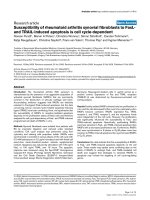Báo cáo y học: "What can chronic arthritis pain teach about developing new analgesic drugs" ppt
Bạn đang xem bản rút gọn của tài liệu. Xem và tải ngay bản đầy đủ của tài liệu tại đây (38.33 KB, 3 trang )
279
MTX = methotrexate; NSAID = non-steroidal anti-inflammatory drug; OA = osteoarthritis; RA = rheumatoid arthritis.
Available online />Despite the availability of opium and willow-bark derivatives
for centuries, chronic pain remains an important unmet
public health need. Although definitive epidemiologic data
are lacking, millions of Americans [1] live with serious
(malignant and non-malignant) chronic pain; this pain
subsequently affects almost every aspect of their lives. In
fact, a recent study suggests that chronic pain has a
greater impact (about US$100 billion annually) on the US
economy in health insurance, lost wages, and reduced
productivity than any other chronic condition including
heart disease, hypertension, and diabetes [2]. Unmet
needs for analgesia are also recognized by the US
Congress, which has declared 2000–10 to be ‘The
decade of pain management and research’. Although the
recognition of pain as the ‘fifth vital sign’, continuing
improvements in professional pain education, and the
development of pain and palliative care services hold
promise for improved pain therapy, these efforts are
ultimately limited by the safety and efficacy of opioids, non-
steroidal anti-inflammatory drugs (NSAIDs) and all their
variations and formulations. It has therefore been argued
that the apparent continuing failure to develop
fundamentally new and different analgesic drugs
contributes significantly to the unmet needs in chronic pain
management [3]. This further suggests that there is a need
for new strategies and new thinking regarding therapeutic
targets for treating pain, both acute and chronic.
To rheumatologists, the statement that there are unmet
clinical needs in chronic pain is probably not too
surprising because they deal routinely with chronic pain in
their patients with osteoarthritis (OA), a leading cause of
chronic pain and disability in the USA estimated to affect
nearly 21 million Americans [4]. Treating the chronic pain
associated with OA alone costs millions of dollars in direct
analgesic drug costs, as well as those costs necessary to
deal with the inevitable adverse events (namely
gastrointestinal bleeds) that these drugs also bring to the
therapeutic table. Similarly, pain associated with other
arthritic diseases such as rheumatoid arthritis (RA), which
affects an estimated 1% of US adults, is another example
of other causes of chronic pain in rheumatic diseases.
Possibly even more familiar to rheumatologists today is the
increasingly recognized condition called fibromyalgia that
currently represents a substantial unmet need and clinical
challenge for pain therapy. In fact, probably all rheumato-
Commentary
What can chronic arthritis pain teach about developing new
analgesic drugs?
James Witter
1
and Raymond A Dionne
2
1
Center for Drug Evaluation & Research (CDER), FDA, Rockville, Maryland, USA
2
National Institute of Dental and Craniofacial Research, NIH, Bethesda, Maryland, USA
Corresponding author: Raymond Dionne,
Published: 15 October 2004
Arthritis Res Ther 2004, 6:279-281 (DOI 10.1186/ar1450)
© 2004 BioMed Central Ltd
Abstract
Chronic pain remains an important public health need with greater impact on the US economy than
most other chronic conditions. Current pain management is largely limited to opioids and non-steroidal
anti-inflammatory drugs, indicating a gap in the translation of new knowledge to the development of
improved pain treatments. Strategies suggested include the re-evaluation of current drug screening
methods, a recognition that molecular-genetic events occurring acutely contribute to the development
of pain chronicity, the validation of analgesic targets in the intended patient population, consideration
of the unique genetic profile that varies between individuals, and the introduction of individual response
measures to improve the capture of outcomes in clinical trials.
Keywords: analgesics, chronic pain, drug development, individual responses, pain mechanisms
280
Arthritis Research & Therapy Vol 6 No 6 Witter and Dionne
logic diseases can evoke pain at some point that is often
poorly managed. Therefore, patients who frequent a
rheumatologist in the clinic represent a substantial portion
of the total US burden of chronic pain and also arguably
present the spectrum of mechanisms that cause such pain.
Despite the sequencing of the human genome, the cloning
of animals and the advent of clinically useful biological
agents to treat a wide variety of diseases (especially
rheumatic diseases), few truly new and widely effective
molecular entities designed to treat pain mechanisms have
entered the analgesic clinic in the past 10–20 years. Why,
then, is there such a gap in the translation of new knowledge
and technologies into different and better treatments for one
of the oldest medical problems known to humans?
It is likely that the potential of genomics and proteomics
will permit a better description of the molecular-genetic
basis of acute and chronic inflammation. These new tools
and thinking will also probably lead to a deeper
understanding of the plasticity in the nervous system that
is argued to be an important pathway to chronic pain that
no longer depends on obvious peripheral causes. It is
therefore likely that this new knowledge will lead to new
targets for analgesia and new chemical entities entering
the drug development pipeline of the future. However,
existing clinical trial settings have the apparent limitation of
only identifying drugs with mechanisms of action similar to
already approved drugs, while screening out analgesics
with completely new mechanisms of action, as these
clinical models have usually been validated by demon-
strating opioid or NSAID activity. This circular process
therefore may fail to detect drugs acting through non-
opioid or non-NSAID mechanisms because these investi-
gational analgesics might never advance beyond the initial
proof-of-concept studies. The high cost of drug
development, now estimated at $800 million per new
chemical entity [5], may further act as a deterrent to
developing truly novel analgesics, because a failure would
be too costly.
A recent workshop organized jointly by the National
Institutes of Health and the US Food and Drug
Administration [3] identified several methodologic issues
that act as barriers toward the development of novel
analgesic drugs. It was noted, for example, that most pain
research conducted in the past 150 years has studied
transient pain that does not result in tissue damage
sufficient to have much relevance to clinical medicine as a
model for chronic disease. The artificial temporal
differentiation between acute (days to weeks) and chronic
(months) pain may also be problematic because key
pathophysiologic processes may diverge early in the
development of pain chronicity. Chronic pain studies
based on enrolling patients who have had pain for months
might miss critical points for evaluating an intervention
aimed at preventing or pre-empting the development of
the chronic disorder and subsequent irreversible changes.
This situation may be especially true for the contribution of
peripheral and central sensitization to the transition from
acute injury to chronic pain.
Conversely, traditional animal and clinical models
employed to screen for analgesics might not be useful for
studying the transition from acute injury to chronic pain if
the critical events occur days after the injury when acute
pain is usually resolving symptomatically. This limitation is
even more important if these same pain models are not
able to identify analgesics that have a fundamentally
different mechanism of action from that of traditional
NSAIDs or opioid-type drugs. This discrepancy is
illustrated by the promise suggested for neurokinin-1
antagonists by animal-based studies and their failure to
demonstrate analgesic activity in human clinical conditions
[6]. This disconnect may also illustrate that currently
available non-clinical animal models are not good
surrogates for the clinical needs of chronic pain.
Therefore, if non-clinical models that are sensitive to
mechanisms other than anti-inflammatory effects cannot
readily be developed, other alternatives in the clinical
setting need to be explored.
A shift in the strategies used for analgesic drug
development is called for by Woolf and colleagues [7].
They argue that understanding analgesic mechanisms
provides an opportunity to move forward by assessing the
effects of investigational analgesics on the mechanisms
involved rather than the empirical method that has driven
analgesic development in the past. The symptoms that
comprise the pain experience are the result of specific and
identifiable changes in the nervous system. Analgesics,
Woolf argues, do not have intrinsic pain-relieving actions;
rather, they produce their effects because they interfere
with the mechanisms that produce the pain. Analgesia will
not occur if the particular mechanism that a drug interacts
with is not present in the patient. Conversely, if a patient
has a pathophysiologic process that is driving their pain,
that mechanism should be the target of action of the
analgesic. This extends to the clinical differences between
acute and chronic pain; they are not distinct states of the
nervous system. Acute pain refers to pain at certain times
after initiating events that may be transient; chronic pain
refers to the persistence of the mechanisms activated by
the tissue injury. The way to move forward clinically is to
measure multiple signs and symptoms, not just global
measures such as patient report of pain, and to validate
hypotheses about the mechanisms that convert a short-
lasting pain into a pain that persists and becomes
intractable rather than returning to baseline.
Pharmacogenomics is another possible strategy for
enhancing analgesic drug development and pain therapy. It
281
rests on the ability to relate the responses of an individual
to a drug regimen to some aspect of their genetic
composition. If demonstrated in a sufficient number of
individuals, it might be possible to derive a causal
relationship between specific genetic polymorphisms and
therapeutic response. If one’s genetic profile influences
one’s molecular pathways for pain and response to an
analgesic in terms of efficacy or safety, these important
factors may revolve around the unique individual.
Properly constructed individual response measures hold
the potential to improve the capture of clinical outcomes in
clinical trials; more so than approaching the same problem
from a group or means perspective (RA Dionne, L
Bartoshuk, J Mogil and J Witter, unpublished work).
Validating the role of an individual responder approach for
clinical analgesic trials will better capture clinically
important outcomes in clinical trials, possibly leading to the
identification of subgroups of patients whose underlying
molecular-genetic pain mechanism provides a favorable
therapeutic ratio for an analgesic drug.
Therefore, in thinking about the transition from acute pain
after tissue injury to chronic pain sustained in the absence
of damage, one can then ask the following types of
question: How much of chronic pain is caused by
mechanisms that are initiated by acute pain processes in
the periphery, for example inflammation; by reactive
processes in the central nervous system, for example
sensitization due to the release of excitatory amino acids;
and by the continuing disease process, for example RA or
OA? Should drug selection for these distinct processes
vary to target the acute inflammatory response, the
transition to chronicity, or the underlying disease process
to minimize continued destructive changes despite
successful symptom management? Should pivotal clinical
trials for screening and confirming investigational drugs
continue to be based on clinical models that have been
validated with the use of existing drug classes (NSAIDs,
opioids), or will scientific advances translate more
successfully into improved pain therapy by the
development of new approaches to clinical evaluation of
putative analgesic drugs?
Both the drug methotrexate (MTX) and the biologic agent
etanercept are examples of therapies widely employed to
treat rheumatoid arthritis. The evidence to support such
use comes from clinical trials that have used the American
College of Rheumatology (ACR) 20 responder analysis as
the endpoint. Pain relief is the primary goal of any therapy
in RA, and the ACR 20 employs pain (100 mm visual
analog scale) as one of its endpoints. Because the
response to MTX generally takes days to weeks to
become apparent, it is not surprising that there is no
information available in the literature to suggest that MTX
would be useful to treat acute pain. This would therefore
suggest that whatever mechanisms underlie how MTX
improves pain in RA are different from those that cause
pain in an acute situation. In contrast, the pain relief
associated with the use of etanercept has been described
as rapid and dramatic, suggesting that the tumor necrosis
factor pathway has an equally important role in chronic
pain and the other processes associated with chronic
inflammation. It is noteworthy that neither MTX nor
etanercept has found use in the chronic pain associated
with fibromyalgia. It is therefore unknown how these two
arthritic therapies differ in their ability to interfere with the
underlying disease processes that contribute to
nociceptive processes versus the symptom complex called
pain as experienced in the somatosensory cortex.
Furthermore, it is likely that neither agent would have
survived for long in a traditional analgesic development
program with a ‘pivotal’ clinical trial in an acute anti-
inflammatory model such as oral surgery or bunion surgery.
So perhaps a reconsideration of acute versus chronic
pain, and acute versus chronic inflammation, might be
useful as we move forward in this ‘Decade of pain
management and research’. A better understanding of the
relationships that exist mechanistically in acute versus
chronic pain might allow the development of new
therapies that will optimize the treatment of pain. Acute
pain that is treated from an understanding of both a
mechanistic and clinical perspective may lower the
probability that such acute pain might ultimately contribute
to chronic pain. Chronic pain that is treated from an
understanding of its mechanistic and clinical perspectives
might then be pain that is ultimately cured.
Competing interests
The author(s) declare that they have no competing interests.
Acknowledgements
The views expressed are those of the authors. No official support or
endorsement by the US Food and Drug Administration or the National
Institutes of Health is provided or should be inferred.
References
1. Louis Harris and Associates: National pain survey. Conducted for
Ortho-McNeill Pharmaceuticals, 1999. [ />healthinfo/painmanagement/related/survey.html]
2. Stewart WF, Ricci JA, Chee E, Marganstein D, Lipton R: Lost
productive time and cost due to common pain conditions in
the US workforce. JAMA 2003, 290:2443-2454.
3. Dionne RA, Witter J: NIH–FDA Analgesic Drug Development
Workshop: translating scientific advances into improved pain
relief. Clin J Pain 2003, 19:139-147.
4. Arthritis Foundation [www.arthritis.org]
5. Anon.: Costing drug development [editorial]. Nat Rev Drug
Discov 2003, 2:247.
6. Boyce S, Hill RG: Discrepant results from preclinical and clini-
cal studies on the potential of substance P-receptor antago-
nist compounds as analgesics. In Proc 9th World Congr Pain,
Progress in Pain Research and Management. Volume 16. Edited
by Devor M, Rowbotham MC, Wiesenfeld-Hallin Z. Seattle: IASP
Press; 2000:313-324.
7. Woolf CJ: Pain: moving from symptom control toward mecha-
nism-specific pharmacologic management. Ann Intern Med
2004, 140:441-451.
Available online />









